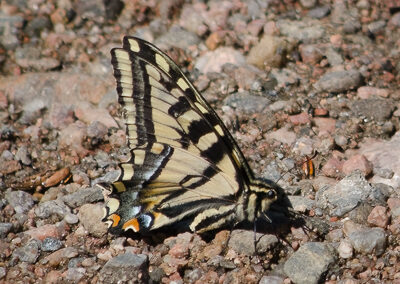
(Pterourus rutulus – formerly Papilio rutulus)
Swallowtails
Appearance: Above, boldly colored black and yellow with four broad black stripes crossing the forewing and the innermost stripe continuing across the hindwing. The trailing edges of both wings have broad black margins with yellow crescents. The underside is paler yellow with the same black stripe pattern visible and blue edging on the wings. Hindwing has single long tail. Entire body is also patterned in black and yellow.
Wingspan: Large; 2 1/2 to 4 inches.
Habitat: Woodlands near streams and other open areas often near water; plains, foothills, montane.
Flight Times: April through August, but primarily June to mid-August; one to two broods. Chrysalis overwinters.
Larval Foodplant: Leaves of a wide variety of shrubs and trees such as chokecherry, willows, alder, aspen, maples, wild plum, and cottonwoods.
Did You Know…
Easily noticed and conspicuous in flight, the Western Tiger Swallowtail can be joined in flight during the summer months with companions like the Pale, Anise and Two-Tailed Swallowtails. In spring, groups of males puddle and patrol up and down stream corridors looking for a mate. Young larvae look like bird droppings.

